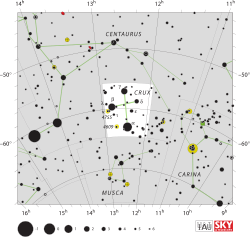Crux
Crux (IPA: /ˈkrʊks/), commonly known as the Southern Cross, is a constellation that can be seen by people in the Southern Hemisphere. Its four brightest stars are in the shape of a cross. The name Crux is the Latin word for a cross. It is a small constellation, but the four main stars are bright, so the cross shape is easily seen in the sky. Each of the four stars has an apparent visual magnitude brighter than +2.8. The four stars point approximately in the directions of north, south, east and west.
| Constellation | |
 | |
| Abbreviation | Cru |
|---|---|
| Genitive | Crucis |
| Pronunciation | /krʌks/, genitive /ˈkruːsɪs/ |
| Symbolism | Southern Cross |
| Right ascension | 12.5h |
| Declination | −60° |
| Quadrant | SQ3 |
| Area | 68 sq. deg. (88th) |
| Main stars | 4 |
| Bayer/Flamsteed stars | 19 |
| Stars with planets | 2 |
| Stars brighter than 3.00m | 5 |
| Stars within 10.00 pc (32.62 ly) | 0 |
| Brightest star | Acrux (α Cru) (0.87m) |
| Messier objects | 0 |
| Meteor showers | Crucids |
| Bordering constellations | Centaurus Musca |
| Visible at latitudes between +20° and −90°. Best visible at 21:00 (9 p.m.) during the month of May. | |

Crux was first described by the Italian navigator Andrea Corsali in 1515.[1] In the past, sailors used Crux to help with navigating across oceans.
The Southern Cross is used as a symbol in many Southern Hemisphere countries and states. It appears on the flags of Australia, Brazil, New Zealand, Papua New Guinea and Samoa.
It was used on the flag flown by miners in Ballarat, Victoria, during the 1854 rebellion known as the Eureka Stockade. The flag has been used as a symbol of protest in Australia since then.
Related pages
changeReferences
change- ↑ Ridpath, Ian. "Crux: The southern cross". Star Tales. Retrieved 28 January 2013.